Friday, February 27, 2009
More for your listening pleasure
Anyway, my new favorite podcast is the Paranormal Podcast, which features a thirty-minute to hourlong interview with an author/ investigator/what-have-you in each episode. It's not nearly as kooky as you might think—there are lots of tidbits to interest even confirmed skeptics (how the CIA employs psychics—"remote viewers" —on intelligence-gathering missions; the scientific aspects of after-death experiences; and suchlike). One of the psychics interviewed on the show posited that twenty percent of our thoughts don't actually belong to us, which is something even a die-hard skeptic would find difficult to reject out of hand (though I do wonder how one can possibly quantify it!)
And if you're interested in folklore, the episode on zombies is a must-listen. The guest author, Bob Curran, is from Northern Ireland, and he tells a wonderful, possibly-true story about a grandfather who comes back from the graveyard to visit his family. Well worth checking out on iTunes.
Thursday, February 19, 2009
Plum Truffle weeeeeeeeeeeeeee!
It's not a pattern, so you make your own calculations and adjustments as you go along; it sounds scary, but I definitely feel like I've become a better knitter because of it. This tutorial was published over a year ago now, and it was high up on my Ravelry queue for almost as long (giving it frequent glances of longing in between churning out Christmas gifts...)
The yarn is discontinued Rowan Yorkshire Tweed Aran, which I picked up for less than half price on eBay two years ago. I was planning to make this, but fell out of love with it at some point. (I'm already thinking about making a Truffle #2, because I think it would look terrific in a lighter-color yarn.) This dark rich plum tweed (with fuschia, rust, bright purple, and emerald-green flecks) is nice too, though the wool is unevenly spun, which is irritating when the yarn gets as thin as a strand of sewing thread. I've found a knot in almost every ball, too. The cheek of Rowan, charging $16 a ball! I bet quality control issues were part of why the yarn was discontinued.
 I was anticipating a fair amount of frogging and re-knitting when it came to the yoke, which requires short rows to get the cabled panel to hug your collarbone area, but I whizzed through it in four days or so. The horseshoes tend to vary in size, but I decided not to drive myself crazy counting rows and half-rows or else I'd never finish the darn thing.
I was anticipating a fair amount of frogging and re-knitting when it came to the yoke, which requires short rows to get the cabled panel to hug your collarbone area, but I whizzed through it in four days or so. The horseshoes tend to vary in size, but I decided not to drive myself crazy counting rows and half-rows or else I'd never finish the darn thing. I'm using a cable pattern from Vogue Stitchionary for the yoke (Horseshoe #1, page 27) and this cable from Barbara Walker’s Charted Knitting Designs for the front. I really enjoyed knitting the test swatch for the cable—this is going to sound really dorky, but watching the traveling cables emerge feels kind of magical.
I'm using a cable pattern from Vogue Stitchionary for the yoke (Horseshoe #1, page 27) and this cable from Barbara Walker’s Charted Knitting Designs for the front. I really enjoyed knitting the test swatch for the cable—this is going to sound really dorky, but watching the traveling cables emerge feels kind of magical.
My grandparents recently gave me the pick of their button collection (every time a shirt got too worn out even to donate to Goodwill, they snipped off the buttons and dropped them in a rusty old candy tin). From all the buttons I picked up from them, I found plenty of clear plastic 1 1/8” buttons for the inside buttonband (meaning that the buttons don't all have to match, so long as they're the same size). Like I said, I've been trying to work with materials already on hand whenever possible. It feels so good to be thrifty, and of course I've benefited from my grandparents' thriftiness as well. (Though come to think of it, didn't I learn how to be thrifty from them in the first place?)
Ravelry project link here.
Thursday, February 12, 2009
Lolly Willowes
 I've been fairly preoccupied with the subject of witchcraft (in all its forms and fakery) for this past year and a half or so. With that in mind, my friend Deirdre lent me her copy of Lolly Willowes, a novel by Sylvia Townsend Warner published in 1926.
I've been fairly preoccupied with the subject of witchcraft (in all its forms and fakery) for this past year and a half or so. With that in mind, my friend Deirdre lent me her copy of Lolly Willowes, a novel by Sylvia Townsend Warner published in 1926.The novel is beautifully written, and I was completely engrossed for the first two chapters. The natural imagery is wonderfully vivid—a "thick roof of lime trees" in a churchyard, or
[She] only cried when alone in the potting shed, where a pair of old gardening gloves repeated to her the shape of her mother's hands.At first, Lolly Willowes reminded me, in very general terms, of Kate Chopin's The Awakening, except our protagonist is a maiden aunt who finds satisfaction in nature (she fills her tiny bedroom with exotic flowers, gathers plants to make herbal remedies, and goes for all-day walks in the forest) rather than illicit romance. Laura—called Lolly by her nieces and nephew—doesn't break free of her stultifying London life under her brother's thumb until halfway through the book, but I'm not one of those readers who gets annoyed with the writer when "not much happens" (so long as the prose is good).
I loved the way this novel began, and I wanted to love it all the way through. But...
I'd better back up and read you a few lines off the back cover:
After twenty years of self-effacement as a maiden aunt, she decides to break free and moves to a small Bedfordshire village. Here, happy and unfettered, she enjoys her new existence nagged only by the sense of a secret she has yet to discover. That secret—and her vocation—is witchcraft, and with her cat and a pact with the Devil, Lolly Willowes is finally free.Here's the problem. There's absolutely no hint of supernatural activity until page 165 (out of 247 pages)—so that when she finds a strange kitten inside her (previously locked) parlor, the kitten bites her, and she 'realizes' she's entered into a pact with the Devil, I had to wonder if the promise of witchcraft on the back cover was nothing more than a delusion on Laura's part. It would have made sense if her pact with the Devil were something she had imagined to make her life more interesting, but it's not. It's real, and most of the other villagers have made the same bargain. But for a few pages there, until she goes to a midnight Sabbath attended by all the rest of the village, I was convinced that Lolly is mentally ill.
As a writer, I'm very conscious of this basic principle of consistency. The writer makes a sort of contract with the reader on the very first page, the very first line even. You might not have any idea yet where this story is going to go, but you ought to know what sort of world the characters inhabit. So to begin a story in an all-too-realistic situation and end it with a conversation with Satan (who is posing as an easygoing gardener) is, in a sense, pulling a fast one on the reader. It feels cheap. I'm not saying an imp should have jumped out of a hole and cried "tee hee, I'm the Devil's minion!" before the first paragraph was out; but however it's done, the reader should proceed with the distinct impression that there is a supernatural layer to this story, a dark secret to which she'll eventually be made privy.
When I finished the novel, I googled in search of some discussion on Lolly Willowes that might validate my feelings of disappointment. The novel is considered, by feminist readers especially, to be an unjustly forgotten classic, but virtually none of the blogs or other websites I visited mentioned the inconsistency that had partially spoiled the story for me.
I had lent the book to my mother to read while I finished Hogfather over the holidays, and I wasn't fazed when she told me she hadn't cared for it much—our literary tastes don't always overlap. But when I finished the novel, I realized she'd had the very same reaction that I had. "It just doesn't work," she said. So it wasn't just me.
Despite the consistency issue, Lolly Willowes is still worth a read for all its fine descriptive passages and classic feminist message. I just wish I could recommend it with a whole heart.
Sunday, February 8, 2009
Tips for a Happier Irish Holiday
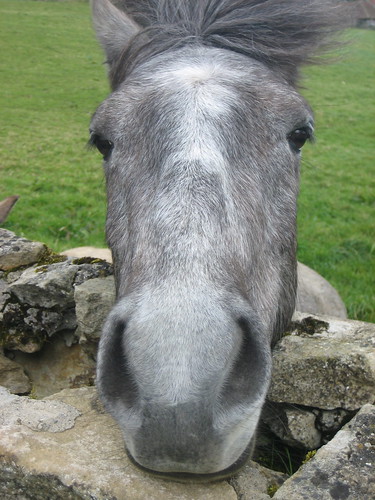 At this time of year folks are trying to distract themselves from the winter doldrums by planning their summer vacations, so what better time to offer a bit of advice if you happen to be coming to Ireland? (I'm writing this in the hope that I might snag a few random Googlers, so if that's you, you can read more about my guidebook here. The second edition doesn't come out until next year, I'm afraid. More on that later.)
At this time of year folks are trying to distract themselves from the winter doldrums by planning their summer vacations, so what better time to offer a bit of advice if you happen to be coming to Ireland? (I'm writing this in the hope that I might snag a few random Googlers, so if that's you, you can read more about my guidebook here. The second edition doesn't come out until next year, I'm afraid. More on that later.)1. Look beyond Dublin! So many visitors spend their entire holiday in the capital. You'll have to travel outside the city to see the real Ireland. I'm not saying you've got to spend a full day on the bus to Donegal—even just a day trip south into the Wicklow Mountains will add a whole new dimension to your visit.
2. Don't try to see too much. I hear people talking about renting a car and driving from Dublin to Galway to the Cliffs of Moher to Killarney and the Ring of Kerry to Cork to Waterford to Glendalough and back to Dublin...all in the span of a week! I say it's better to focus on two or three places in that week—relax, take your time, see it properly and leave yourself a couple hours to savor a pint at a cozy old-fashioned pub. You can always see the rest of those places on your next holiday.
3. Get off the beaten track, or visit popular attractions in the off season. The times I've most enjoyed traveling around Ireland have been the times I've stumbled upon a wonderful place it seems like nobody else in the world knows about. I try to encourage people to seek out the more wild and remote places (County Mayo, anyone?), rather than just going to the Cliffs of Moher or Killarney like everybody else does. That's not to say the most popular tourist attractions aren't deservedly so, but crowds can sometimes detract from your enjoyment of a place. Try spending a week in Donegal instead of Kerry for a more relaxing (but just as scenic) vacation. (Can you tell I really like Donegal?)
4. Buy handmade. If you're looking for an Aran jumper, it's worth investing €100 or more in a handknit garment. (I heard a rumor once about machine-knit sweaters in one of the larger, more commercial shops actually being manufactured in Guatemala. It might not be true, but when so many sweaters don't have a "made in Ireland" label it leaves room for doubt, doesn't it?) For a gorgeous handknit sweater you can wear for the rest of your life, I recommend O'Maille's on Quay Street in Galway or Sarah Flaherty at Dun Aengus on Inis Mór (the largest of the three Aran Islands).
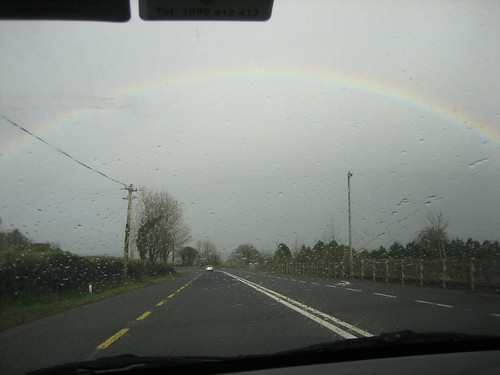 5. Don't complain about the weather. You know it rains a lot in Ireland—that's why the grass is so green! When tourists complain about the rain, it just comes off sounding really ungracious. If you don't like the prospect of putting on a slicker and stout shoes and going for a walk in inclement weather, go to Greece or the Bahamas instead.
5. Don't complain about the weather. You know it rains a lot in Ireland—that's why the grass is so green! When tourists complain about the rain, it just comes off sounding really ungracious. If you don't like the prospect of putting on a slicker and stout shoes and going for a walk in inclement weather, go to Greece or the Bahamas instead.And a corollary, 5A: Don't let the weather dictate your itinerary. Put on your raingear and get to it!
And a further corollary, 5B: In my experience, April and May are the sunniest months. (The last couple of summers have been really wet!) Also, Wexford and the other south-eastern counties get less rainfall than elsewhere in the country (which is why the tourist board touts the region as the "Sunny Southeast.")
 The weather here is sometimes gorgeous. Honest! I took this pic of a cloudless sky on 31 May 2006 in Ardmore, County Waterford.
The weather here is sometimes gorgeous. Honest! I took this pic of a cloudless sky on 31 May 2006 in Ardmore, County Waterford.Enjoy!
And P.S.--please feel free to add your own advice in the comments section. You can also give me a recommendation (a pub, B&B, or what have you), and if I go there and like it I'll thank you on my second-edition acknowledgments page. Go raibh maith agaibh!
Thursday, February 5, 2009
Edwardian Crochet

Here are those scans of the crochet books my uncle gave me. I'd love to see this yoke on a sun dress:

Isn't it lovely? I really have to learn how to crochet properly. And sew, for that matter.
Tuesday, February 3, 2009
Connemara National Park
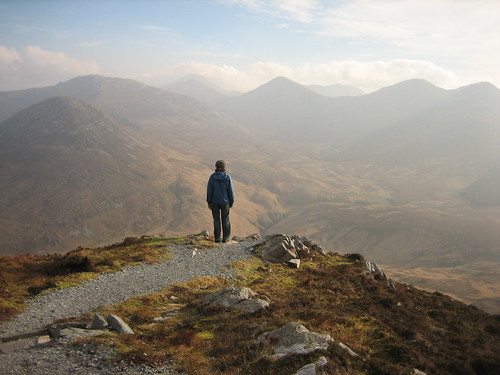 For Brendan's birthday we took the bus out to Connemara National Park for a night, and everything about our mini-holiday was perfect. The weather was crisp and clear, we had nice meals in the Letterfrack pubs (Veldon's and the Bard's Den; the latter has a slightly more gourmet menu, but the staff is friendlier at Veldon's), and we went for the most exhilarating walk up Diamond Hill, a.k.a. Bengoora, the smallest of the Twelve Bens. (You can see the rest of them in the background in the photo above.)
For Brendan's birthday we took the bus out to Connemara National Park for a night, and everything about our mini-holiday was perfect. The weather was crisp and clear, we had nice meals in the Letterfrack pubs (Veldon's and the Bard's Den; the latter has a slightly more gourmet menu, but the staff is friendlier at Veldon's), and we went for the most exhilarating walk up Diamond Hill, a.k.a. Bengoora, the smallest of the Twelve Bens. (You can see the rest of them in the background in the photo above.)We stayed at a wonderful hostel, The Old Monastery, which hasn't changed at all since I was there with my sister back in 2003. As Brendan said, it's everything a hostel should be, but seldom is: very bohemian (antiques and taxidermies, animal bones hanging on a wall strung with red Christmas lights, a cozy common room with an open fire), clean enough (it's the kind of place that will always have a few cobwebs in the corner), with a friendly welcome and meals included. (A breakfast of porridge and scones is always complimentary, though the hot-pot at dinnertime might have been a one-off—delicious meat-and-potato stew, Brendan's dinner #1.)
Here he is showing off the gloves I made him for his birthday (I didn't make the hat, he got it at O'Maille's):
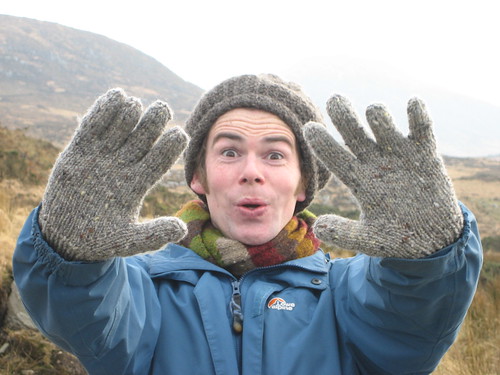
The scarf was his birthday gift last year. Here's a shot taken on the way down Diamond Hill:
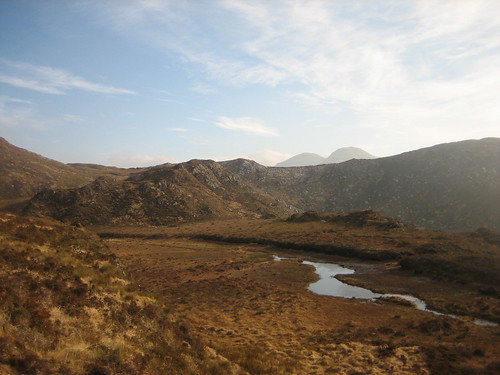 And here's the waterfall on the Ellis Wood nature trail, which is only half a kilometer long:
And here's the waterfall on the Ellis Wood nature trail, which is only half a kilometer long: There weren't many people around (I think half the people we did see were locals), which is all the more reason to come. As you can see, Connemara is just as beautiful in winter—so long as the sun's shining!
There weren't many people around (I think half the people we did see were locals), which is all the more reason to come. As you can see, Connemara is just as beautiful in winter—so long as the sun's shining!
